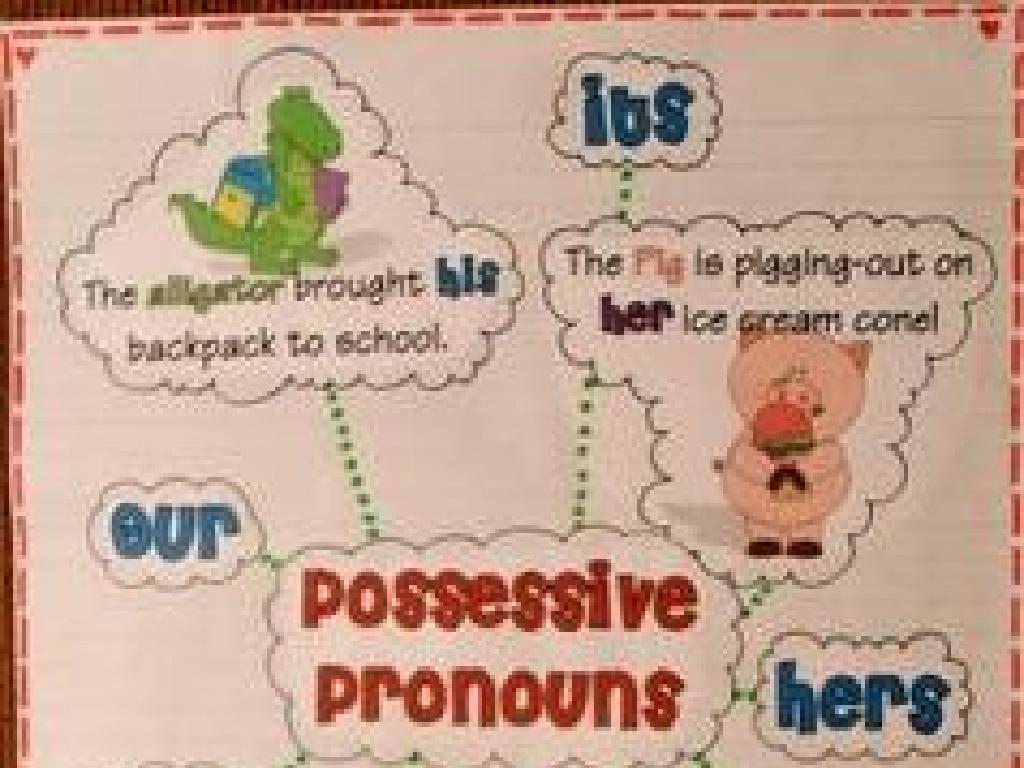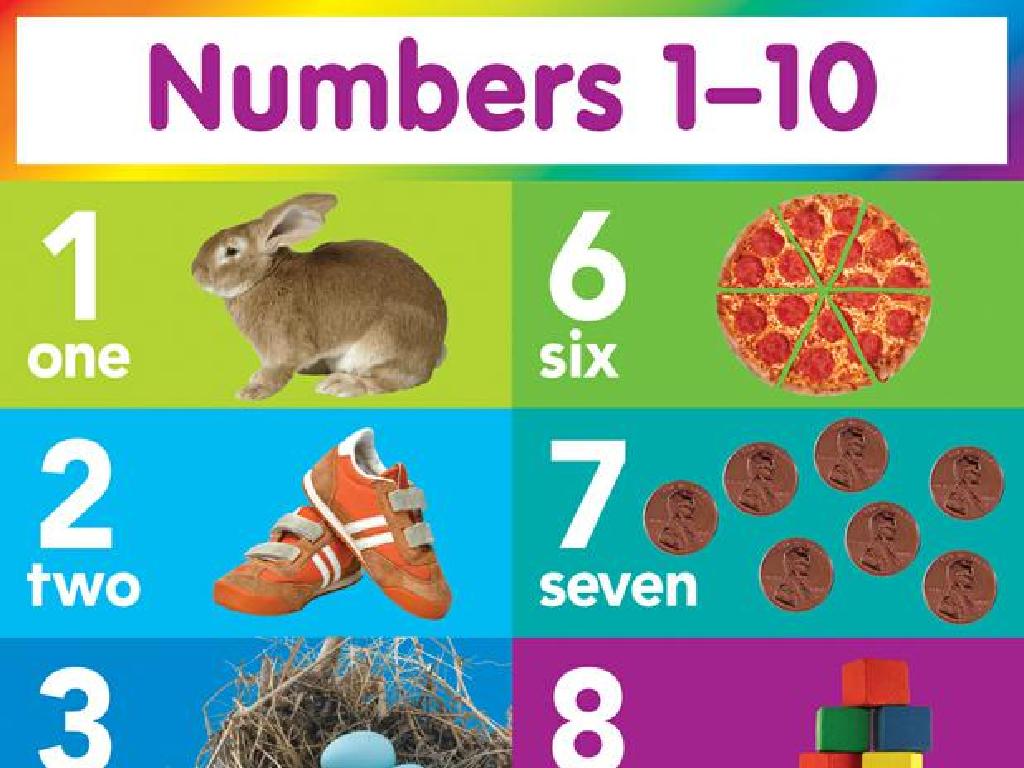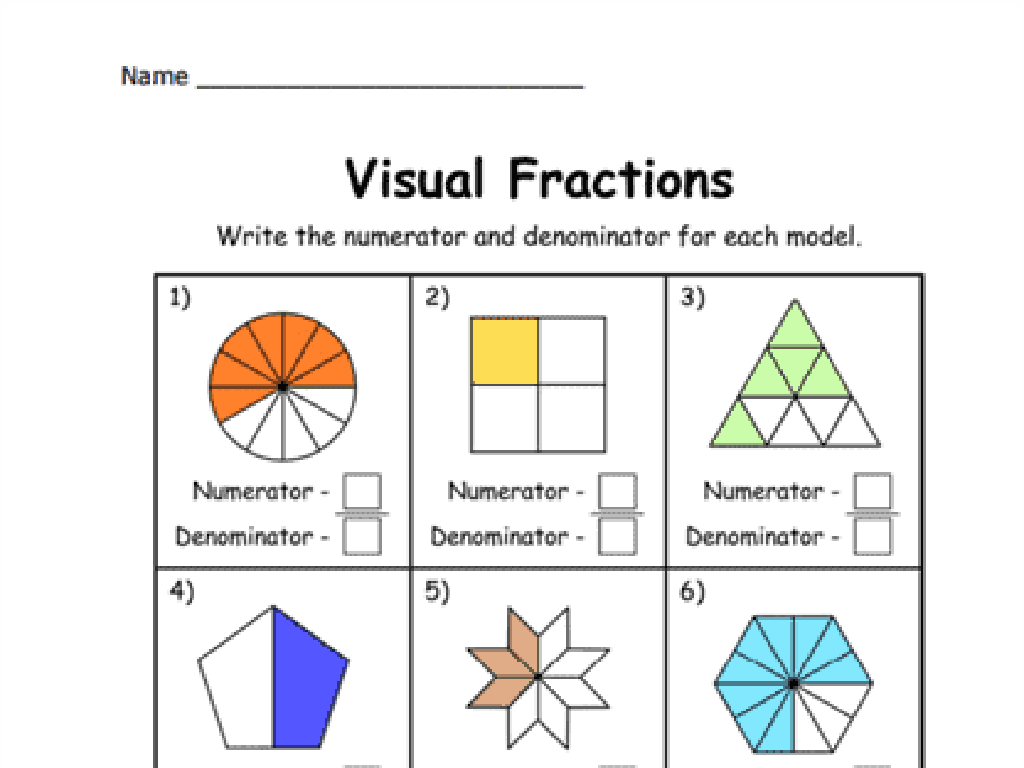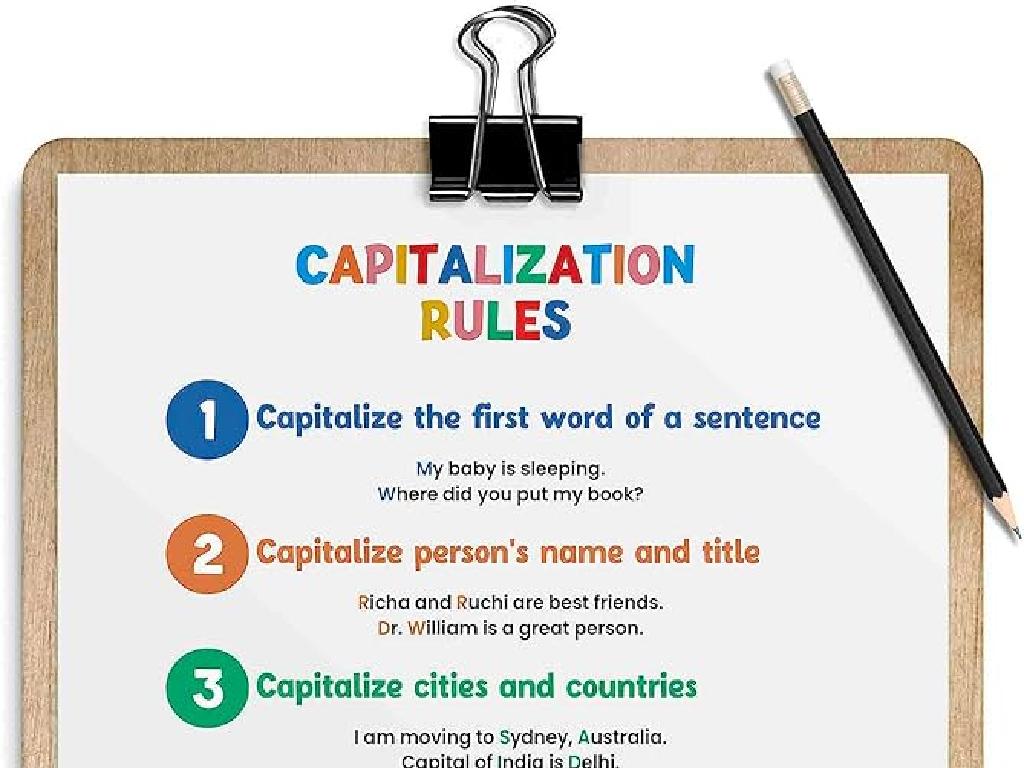Area And Perimeter Of Squares And Rectangles On The Coordinate Plane
Subject: Math
Grade: Sixth grade
Topic: Coordinate Plane
Please LOG IN to download the presentation. Access is available to registered users only.
View More Content
Exploring Area & Perimeter on the Coordinate Plane
– Coordinate plane basics
– A grid with horizontal (x-axis) and vertical (y-axis) lines to locate points
– Defining area and perimeter
– Area measures space inside; perimeter measures the edge
– Real-life applications
– Used in building, farming, and crafting
– Activity: Find area & perimeter
– Use graph paper to draw shapes and calculate their area and perimeter
|
This slide introduces students to the concept of coordinate geometry, focusing on understanding the coordinate plane and the definitions of area and perimeter. Emphasize the practical applications of these concepts in everyday life, such as in construction, agriculture, and various design fields. Encourage students to visualize how area and perimeter are used in planning spaces. The activity will involve students drawing squares and rectangles on graph paper, plotting points on the coordinate plane, and then calculating the area and perimeter of these shapes. This hands-on approach will help solidify their understanding and show them how to apply these mathematical concepts using the coordinate plane.
Recap: The Coordinate Plane
– Understanding the X and Y axes
– Axes intersect at origin (0,0), divide plane into 4 parts
– Exploring the four quadrants
– Quadrants are I (+,+), II (-,+), III (-,-), IV (+,-)
– Properties of each quadrant
– Each quadrant has unique coordinate sign patterns
– Practice plotting points
– Use ordered pairs (x,y) to locate points
|
This slide is a quick recap of the coordinate plane, which is essential for understanding how to calculate area and perimeter on it. Start by revising the X-axis (horizontal) and Y-axis (vertical), and their intersection at the origin. Explain how these axes divide the plane into four quadrants, each with specific properties based on the signs of the coordinates. Positive and negative values determine the quadrant of a point. Reinforce the concept by having students plot points using ordered pairs, which will be crucial for the next part of the lesson where they will apply this knowledge to find the area and perimeter of shapes on the coordinate plane.
Area and Perimeter on the Coordinate Plane
– Area: Space within a shape
– Count squares inside a rectangle on a grid to find area
– Perimeter: Boundary length
– Add up side lengths on the grid for perimeter
– Measure using units
– Use square units for area (sq units), units for perimeter
– Coordinate plane application
|
This slide introduces the concepts of area and perimeter within the context of the coordinate plane. Area is the amount of space inside a two-dimensional shape, which can be visualized as the number of square units that cover the surface within the shape’s boundaries. Perimeter is the total distance around the shape, which can be calculated by adding the lengths of all sides. Emphasize the use of consistent units of measurement for both area (square units) and perimeter (linear units). Provide examples of how to calculate area and perimeter for squares and rectangles using the coordinate plane, highlighting the importance of understanding these concepts for practical applications in geometry.
Calculating Area on the Coordinate Plane
– Area of a Rectangle: A = length × width
– Area of a Square: A = side × side
– Plotting shapes on the coordinate plane
– Identify vertices of the shape on the grid
– Applying area formulas to plotted shapes
– Use coordinates to calculate length and width
|
This slide introduces the formulas for calculating the area of squares and rectangles, which are foundational concepts in geometry. Emphasize the importance of understanding these formulas before applying them to shapes on the coordinate plane. When plotting shapes on the coordinate plane, students should practice identifying the vertices of the shape and use the grid to determine the lengths of sides. Encourage students to work through examples where they apply the area formulas to shapes they’ve plotted on the coordinate plane, reinforcing their understanding of both the formulas and the coordinate system.
Perimeter of Squares and Rectangles
– Rectangle perimeter formula
P = 2(length + width) helps calculate rectangle’s perimeter.
– Square perimeter formula
P = 4 × side is used for finding a square’s perimeter.
– Apply formulas on coordinates
Use grid coordinates to determine length and width.
– Practice with examples
Let’s find the perimeter of a shape at (2,3), (2,6), (5,6), (5,3).
|
This slide introduces students to the formulas for calculating the perimeter of squares and rectangles. Emphasize that perimeter is the total distance around the edge of a shape. For rectangles, add the length and width and then multiply by 2. For squares, multiply the length of one side by 4. When applying these formulas to a coordinate plane, students should use the grid to find the lengths of the sides. Provide practice examples with coordinates on the grid and guide students through the process of calculating the perimeter. Encourage students to work out the perimeter of various shapes on graph paper as homework.
Plotting and Calculating on the Coordinate Plane
– Identify vertices of shapes
– Vertices are corners where two sides meet. E.g., (2,3), (2,5), (4,5), (4,3) form a rectangle.
– Calculate distances between points
– Distance between points is the length of sides. Use the formula ((x2 x1)²+(y2 y1)²).
– Use distances for area
– Area of a rectangle is length × width. Find the length of opposite sides to calculate.
– Use distances for perimeter
– Perimeter is the sum of all sides. Add the lengths of all sides together.
|
This slide introduces students to the concepts of identifying vertices of squares and rectangles on a coordinate plane and calculating distances between these points, which represent the sides of the shapes. Emphasize the importance of plotting points accurately and using the distance formula to find the length of sides. Once students understand how to determine the length of sides, they can use these measurements to calculate the area and perimeter of the shapes. Provide examples of how to apply the distance formula and how to use the lengths of sides to calculate area (length × width) and perimeter (sum of all sides). Encourage students to practice with different shapes on the coordinate plane to reinforce these concepts.
Real-World Applications of Area and Perimeter
– Architects design buildings
– They use area and perimeter to create spaces that are functional and aesthetically pleasing.
– Garden layout planning
– Gardeners use the coordinate plane to map out plant locations and walkways, maximizing the use of space.
– Sports field dimensions
– Designing a field requires precise measurements to ensure it meets regulation sizes for sports.
– Understanding area and perimeter
|
This slide aims to show students how the concepts of area and perimeter they learn in class apply to real-world situations. Architects use these concepts to design buildings, ensuring that each room has the right amount of space for its purpose. When planning a garden, understanding the layout on a coordinate plane can help in efficiently using the available land and creating a pleasing design. Sports fields also need to be designed with exact dimensions for the game to be played properly. Encourage students to think of other areas where they might use these math skills. This understanding helps to solidify the concepts and shows the practical value of their learning.
Class Activity: Design Your Park
– Design a park on a coordinate plane
– Calculate area and perimeter
– Use length x width for area and add all sides for perimeter
– Different sections of the park
– Include sections like playgrounds, ponds, and fields
– Present your park and calculations
|
In this engaging class activity, students will apply their knowledge of geometry to a real-world scenario by designing their own park using a coordinate plane. They will need to calculate the area and perimeter of various sections within their park, such as playgrounds, ponds, and sports fields. This activity will help reinforce their understanding of how to find the area and perimeter of squares and rectangles. Encourage creativity in their designs and ensure they label all sections clearly with their dimensions. After completing their calculations, students will present their park design and share their mathematical findings with the class. This will not only help them practice their math skills but also their presentation skills.
Wrapping Up: Area & Perimeter
– Recap: Area & Perimeter
Area is the space inside a shape, perimeter is the distance around it.
– Homework: Measure your rooms
Use a tape measure to find the length and width of rooms, then calculate.
– Prepare for the upcoming quiz
Review today’s lesson, focus on squares and rectangles on the coordinate plane.
– Practice makes perfect!
|
As we conclude today’s lesson, ensure that students have a clear understanding of the concepts of area and perimeter, especially as they apply to squares and rectangles on the coordinate plane. For homework, students should apply these concepts by measuring the area and perimeter of rooms in their homes, which will help reinforce their learning through practical application. Additionally, inform them about the upcoming quiz to encourage them to review the material covered in class. Provide some example problems and encourage them to practice, as this will help solidify their understanding and prepare them for the quiz.






